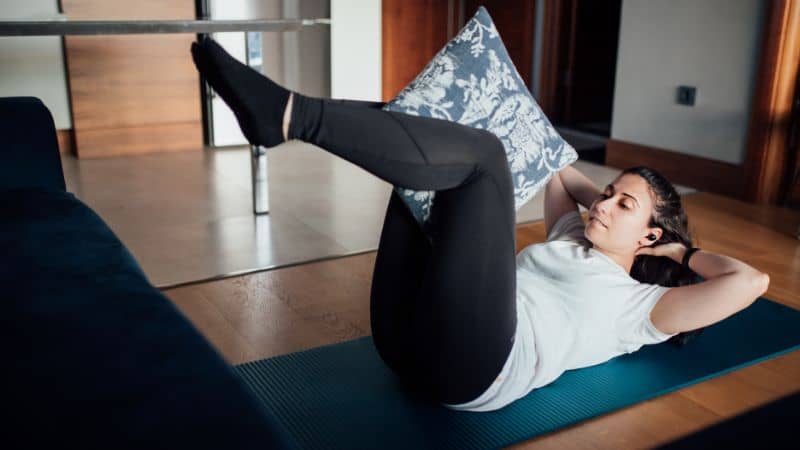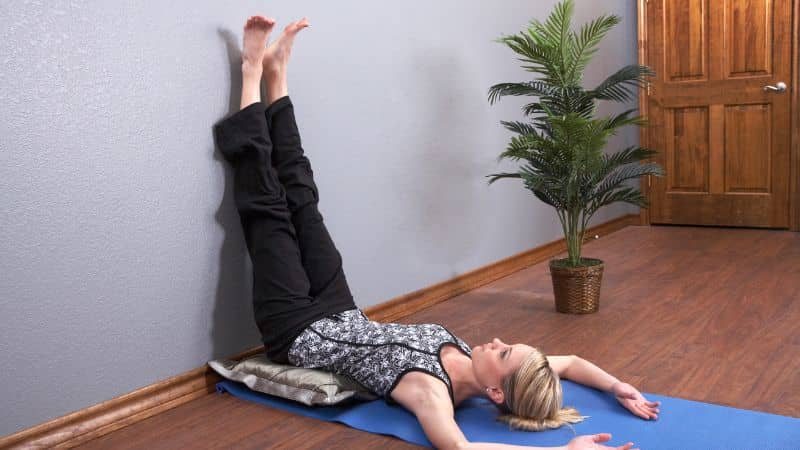
09 Jan 7 Exercises for Diastasis Recti New Moms can Do at Home
Motherhood is a blessing for every woman. Nonetheless, post-pregnancy changes can be frightening at first.
Pregnancy leads to certain physical adjustments to give the baby enough space to develop. In some cases, the pulling apart of the abdominis rectus muscle creates a wider gap between the right and left abs. This condition is called Diastasis recti. Fortunately, effective treatments are available in the form of At-Home Exercises to Heal Diastasis Recti.
As a matter of fact, one out of every two women suffers from the condition referred to as diastasis recti (diastasis – separation; recti – Rectus Abdominis).
For a figure-conscious mum, this is the most disturbing phase. Of course, you cherish the joy of motherhood, but you also long to look and feel the way you did before.
Well, the gap caused by Diastasis recti usually heals on its own as time passes.
Still, targeting these muscles can quicken the healing rate. So, at-Home Exercises To Heal Diastasis Recti is the best way to get started for new moms.
But first, you’ve got to understand How to Know If You Have Diastasis Recti for certain.
How To Know If You Have Diastasis Recti?
Some early symptoms and signs can be indications of Diastasis Recti. Different women experience different indications. Moreover, people can have common issues indicating this health condition.
Some early Diastasis recti symptoms are:
- Bloating
- Constipation
- Poor posture
- Low back pain
- Bulged internal organs when standing
- Vanishing of the bulge when resting
- Greater than a two-finger-width gap between the muscles in your navel area
If you’ve noticed any of these symptoms, it’s time to consult with a professional.
Only a doctor or trained medical personnel can examine and understand How to Know if You Have Diastasis Recti or not.
Still, a simple trick can help you test if you have the condition.
Diastasis Recti Test at Home
- Lie down on the floor. Make sure your knees are bent and your feet remain flat.
- Curl your head up and keep two fingers on your navel or center of your stomach.
- Press them to feel above and below the vertical line.
- If you encounter a gab, that can be diastasis recti.
Small gaps are normal. Thus, push your finger to assess the depth of the gap. One to two fingers’ width is normal. Nevertheless, three or more is a strong sign of diastasis recti.
Though, before reaching a final conclusion, getting confirmation from a medical professional is necessary.
Now, if you’re certain that you do have diastasis recti, here are some of the At-Home Exercises to Heal Diastasis Recti.
At-Home Exercises to Heal Diastasis Recti: Best Natural Treatment
AB Exercises to Heal Diastasis Recti are safe and effective. However, the effects are doubtful.
For assurance, several studies and trials have been conducted to find out the impact of at-Home Exercises on Diastasis Recti. Although some have an unclear verdict, some have sounder conclusions.
A study tried to find the effects of an exercise program (that trained pelvic floor and abdominal muscles) on diastasis recti. Well, one hundred and seventy-five participants took part in the observational study and underwent a postpartum training program for Diastasis Recti Abdominis.
No significant reduction in the prevalence of diastasis was observed for the participants. However, it’s important to note that the study had limitations and the sample included women with and without diastasis.
On the other hand,
Another study explored the effects of supine core stability strengthening and dynamic core stabilization (with plank exercise) on DRA. Participants were randomly placed in either of the exercise groups. After the course of 6 weeks, both groups demonstrated a decline in Diastasis Recti with the supine strengthening program showing slightly better results.
Notably, the study supports the practice of supine core strengthening exercises with scientific evidence. And with this study, the benefits of a well-structured at-home exercise plan to heal diastasis recti become more evident.
So, if you’re struggling with DRA, here are some of the Best Exercises to Heal Diastasis Recti.
#1: Pelvic Tilt

Target – Stabilizes the core and pelvic floor muscles
Sets And Reps – 3 sets of 10 reps
Rest – 30 seconds between each rep
How to Perform Pelvic Tilt?
- Lay on a mat with knees bent and feet lying flat. Make sure your hands are on opposite sides and your palms are facing the ceiling. Now, rotate your hip upward in the direction of your face.
- Involve your core by slanting your pelvis up. Do this in a way that your whole back till the tailbone remains against the floor.
- Remain in this posture for a second and relax.
- Do it again 10 times.
#2: Heel Slide

Target – Core, glutes, and pelvic muscles
Sets And Reps – 2 sets of 10 reps
Rest – 30 seconds between each rep
How to Perform Heel Slide?
- Lay on a mat with knees bent and feet lying flat. Now, put your hands on opposite sides. Palms should be facing the ceiling while toes point upwards. This is the initial position.
- Make your right heel slide to straighten your right leg.
- Maintain the position for a few seconds. Afterward, slide your right heel back to its initial position.
- Do it again 10 times.
- Repeat the same workout with your left leg.
#3: Heel Slide Circles

Target – Core, glutes, and pelvic muscles
Sets And Reps – 2 sets of 10 reps
Rest – 30 seconds between each rep
How to Perform Heel Slide Circles?
- Lay on a mat with knees bent and feet lying flat. Now, put your hands on opposite sides, palms should face the ceiling while your backbone remains in a neutral position.
- Slide off your right heel to straighten out your right leg.
- Perform a “scooping” motion with your leg by elevating your heel off the floor, bending your knee, and then getting back to the initial position.
- Perform the workout 10 times before changing over the legs.
#4: Bent Knee Raise

Target – Core, glutes, and pelvic muscles
Sets And Reps – 3 sets of 10 reps
Rest – 60 seconds between each set
How to Perform Bent Knee Raise?
- Lie down on a mat and keep your knees flexed and feet flat on the floor. Keep your hands by your side, palms facing the ceiling, and your spine in a neutral position. This is the starting position.
- Keeping your knees flexed, lift your right leg off the floor, and then bring it back to the starting position.
- Do this 10 times before switching legs.
You can also use a band (as indicated in the picture) if the position feels uncomfortable or if you need more support.
#5: Pelvic Pillow Squeeze

Target – Core, pelvic muscles, and abductor
Sets And Reps – 3 sets of 10 reps
Rest – 60 seconds between each set
How to Perform Pelvic Pillow Squeeze?
- Lay on your back. Your knees should be bent, your feet flat, your hands should remain on the side, and your palms should face up.
- Put a pillow between your legs while your spine should be in a normal posture.
- Press the pillow with your knees. Hold the position for 3 seconds. Relax.
- Repeat this 10 times.
#6: Slightly Hyperextended Bridge

Target – Core, glutes, quads, and hamstrings
Sets And Reps – 3 sets of 5 reps
Rest – 60 seconds between each rep
How To Perform Slightly Hyperextended Bridge?
- Lay on your back. Bent your knees while keeping your feet and palms flat on the floor.
- Push your pelvis towards the bottom so that your lower back remains against the floor. Well, this is the initial position.
- Exhale, compress your glutes and raise your hips. Elevate your core slightly higher than the normal bridge exercise.
- Remain in this posture for 3 seconds. Now, slowly slide down your back to the floor.
#7: Lying Overhead Reach

Target – Core, glutes, quads, and hamstrings
Sets And Reps – 3 sets of 10 reps
Rest – 60 seconds between each set
How to Perform Lying Overhead Reach?
- Lay on your back. Bent your knees while keeping your feet and palms flat on the floor.
- Push your pelvis towards the bottom so that your lower back remains against the floor.
- While keeping your arms extended, elevate them from the floor above your head. Now, bring them back to the ground.
- Wait for a second and then move your arms slowly to the initial position.
These were some of the Safe Exercises to Heal Diastasis Recti. However, visible differences are subject to a few conditions.
Researchers have received positive outcomes only when the participants strictly followed the physical activity and stayed consistent with a routine.
In fact, performing exercises to reduce the intensity of the DRA is vital.
Research demonstrates how the size of DRA is comparatively higher in non-exercising pregnant women than in exercising pregnant women.
Furthermore, the study showed the role of physical activities in terms of the abdominal muscles by evaluating the presence of DRA in pregnant and postpartum.
Surprisingly, performing the at-home exercises to heal Diastasis Recti isn’t the only thing you can do.
Along with physical treatment, avoiding activities that add to the condition is also necessary. While conducting research for this blog, I encountered that some exercises can even worsen Diastasis Recti.
Exercises To Avoid With Diastasis Recti: Prevent Further Damage
Some workouts can worsen your current Diastasis Recti situation. Thus, experts recommend Diastasis Recti patients avoid doing some exercise.
Diastasis Recti Exercises to Avoid
- Plank
- Sit-ups
- Roll-ups
- Jackknife
- Crunches
- Russian twist
- Full push-ups
- Oblique curls
- Reverse curls
- Bicycle crunches
- Leg up crunches
Doing these exercises may not only prevent progress but may also worsen the condition.
Overall, avoiding doing these exercises obsessively should be a necessary part of your treatment plan.
Adding to it, there is a list of notable points to keep in mind while practicing exercises to heal diastasis recti at home.
Things to Keep in Mind While Performing Exercises to Heal Diastasis Recti
The first thing to keep in mind while healing your diastasis recti with exercise is to stay mindful of posture.
Although there is no “one right posture” for all, you can find your neutral position or stacked position through alignment variation.
For this, align your ribcage on the pelvis in a way that your shoulder, ears, ankles, and knees are in a vertical position. Now feel your weight just in front of your ankles.
This is your stacked position which is recommended to attain while performing breathing exercises and higher-level movements.
The next thing is to keep your muscles connected with the flow of your breathing. Connecting your deep core abdominal muscles, pelvic floor, and back extensors using breathing is an essential step.
Doing this will help your muscles to work in a coordinated way and put pressure on the core and enhance stability through the torso.
Another important step is to coordinate your breathing with every movement. To make complete use of the strength and stability.
To begin with, try to execute your daily life routine. With time and practice, you can also try adding light weights and using gravity as a tool to reconnect.
Lastly, the most crucial thing to keep in mind while you start exercising is to wait for at least 6 months after delivery in general. However, depending on the type of pregnancy and delivery, it’s better to consult the doctor.
Henceforth, complying with the mechanism will only help in reducing DRA. Besides, a more important question is awaiting.
How Long Does It Take to Heal Diastasis Recti with Exercise?
Undoubtedly, this is a very debatable question.
At-Home Exercises to Heal Diastasis Recti have confirmed positive results, though. The differences are observable after 6-week periods.
Irrespective of the length of the result, positive changes are observable in every candidate.
Thus, rather than being overly concerned with the timeframe, performing Diastasis recti corrective exercises for final outcome is more important.
Having said that, every woman is different and so are the results and the pace of improvement.
The width of the Diastasis Recti differs from person to person.
Even the physical difference between person to person differs. Next, the effects of a workout or exercise have different impacts and results.
By the information shared, we’re pointing in the direction that mentioning an exact period to heal the condition doesn’t apply to everyone.
For instance, a female with a wider DRA will take a little longer to heal compared to a woman with a small gap in the abdominal muscles.
Also, workouts show different effects on women depending on their physical features.
In short, in no way one can determine a specific time for healing. The past observations still show good improvements within the timeframe of 2-3 months.
Final Verdict: Is Diastasis Recti Treatable?
Diastasis Recti is a stressful condition for most women, specifically for those excessively concerned about their fitness.
With every second woman facing the condition post-pregnancy, taking measures are necessary.
Studies have shown the positive impact of At-Home Exercises To Heal Diastasis Recti. In fact, including them in your daily routine for at least 6 weeks has confirmed a positive difference.
Thus, you can employ some of these exercises to heal diastasis recti for similar results. However, besides performing these physical activities, more important measures are required.
Try to maintain a good posture as much as possible. Moreover, lifting heavyweight can further increase the gap. So, avoid doing that right away.
When resting, support your back by putting on a pillow underneath. These changes can help you prevent the condition from getting worse.
Here you have it! All the information regarding the natural treatment of Diastasis Recti treatment.
Try these At-Home Exercises To Heal Diastasis Recti to fight off the abdominal gap and enjoy the experience of being a mother without the distress of losing your body in the process.



No Comments